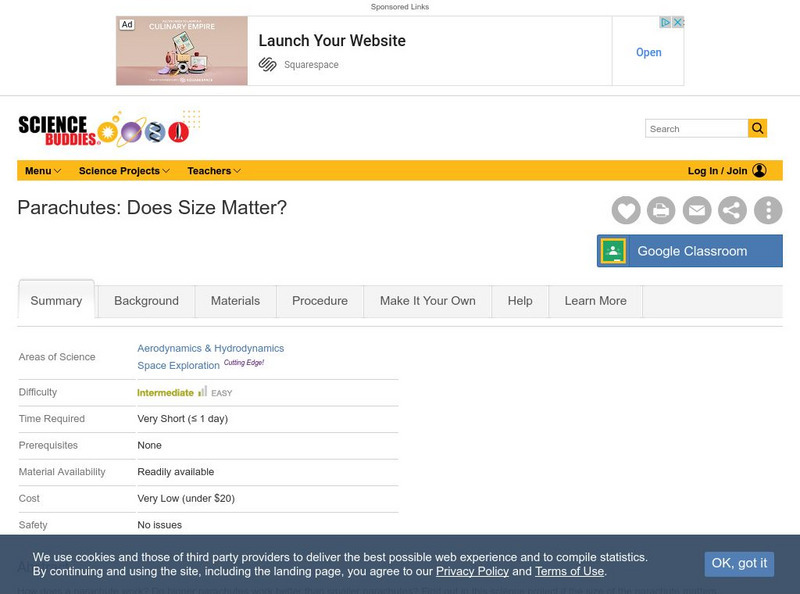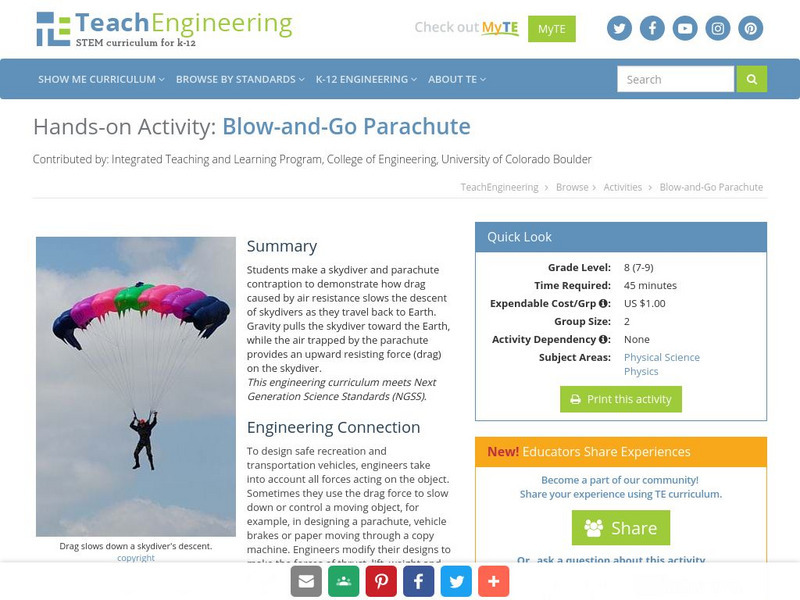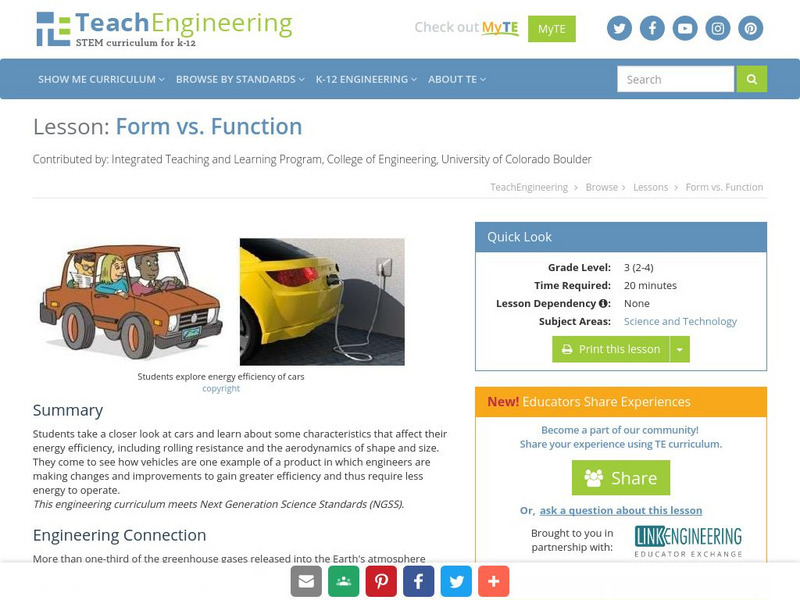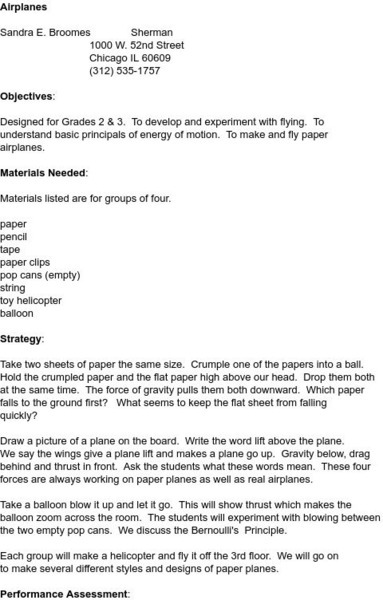Hi, what do you want to do?
Curated OER
How Do Things Fall?
Students observe falling objects. They discover the rate of falling is based on air resistance and not the weight of the objects. They discuss how engineers use this type of information to design aerodynamic shapes.
Curated OER
Balloon Rocket
In this friction investigation worksheet, students follow the directions to construct a balloon rocket. Students use a string lubricated with soap and a drinking straw with a balloon. This is a page from the UK.
Curated OER
Thar She Blows!
Learners identify the advantages and disadvantages of wind farms and turbines. They examine how weather conditions can affect their effectiveness and how engineers are trying to solve the problem. They discover how engineers use this...
Curated OER
Did You Catch My Drift?
Students, through the use of the Curveball interactive software package, become familiar with the way in which the flow of air across or around an object affects its ability to lift, spin, and curve. After reading the explanation given...
Curated OER
Mimicking Nature; Science, Aviation, Flight, Wings
Young scholars consider the relationship between form and flight and investigate the history of man made flight and how wing shape and flexibility affects the maneuverability of an aircraft.
Curated OER
#22c Airplane flight #22d Airplane flight--How High? How Fast?
Students discuss the application of frames of reference to an airplane flying with a constant velocity v through the air.
Curated OER
A New Century Of Flight
Students analyze an article about fight traffic and answer questions. In this investigative lesson students study flight and fill out a worksheet pertaining to the information that they just learned.
Curated OER
Airplane flight
High schoolers learn the basic concepts about airplane flight. They learn the reason jetliner wings are swept back and why jet engines have replaced propellers in high-speed flight.
Curated OER
Reading: An Amazing Swimsuit
In this inventions worksheet, students read a one page text about the new type of swimsuit used in the 2008 Beijing Olympics called the Speedo LZR Racer. Students answer 10 true or false questions about the passage.
Curated OER
Flying Tube
Students investigate how a spinning paper tube generates lift as it travels forward.
Discovery Education
Discovery Education: Inventors and Inventions 2: Air and Space
After discussing important flying inventions, young scholars explore technological design by making paper airplanes.
Smithsonian Institution
National Air and Space Museum: Wright Brothers: Interactive Experiments
Three interactives in an online exhibition about the Wright Brothers. The first is an engineering activity on the forces of flight, and is accompanied by a lesson plan for Grades 6-8. The second is a gallery of original artifacts related...
TeachEngineering
Teach Engineering: Up, Up and Away! Airplanes
The airplanes unit begins with a lesson on how airplanes create lift, which involves a discussion of air pressure and how wings use Bernoulli's Principle to change air pressure. Following the lessons on lift, students explore the other...
Science Buddies
Science Buddies: Design and Launch Bottle Rockets
If you want to discover what makes rockets fly, this is an activity for you. You can even add different features, like fins, a nose cone, and a parachute to find out how these alter the flight!
Science Buddies
Science Buddies: Up, Up, and Away in Your Own Hot Air Balloon!
In this science fair project, students will make hot-air balloons using a toaster and dry-cleaning bags, and see how the size of the balloon affects its flight. The Science Buddies project ideas are set up consistently beginning with an...
Science Buddies
Science Buddies: Riding on Air Build a Real Hovercraft
You will get to build a working hovercraft that will glide over surfaces on a cushion of air in this week long science project. With the use of some power tools, you will create your hovercraft, and ultimately understand how air...
Smithsonian Institution
Smithsonian Learning Lab: How Things Fly: Activities for Teaching Flight
Through this series of three lessons, students will gain an understanding of the basics of flight. They will learn about the four forces of flight and practice their observation skills through a number of fun experiments. In addition,...
NASA
Nasa: Beginner's Guide to Aerodynamics
Includes exhaustive information and a wealth of activities pertaining to aerodynamics and the physics of flight.
Science Buddies
Science Buddies: Parachutes: Does Size Matter?
Experiment with different sizes of parachutes to find out if size matters when slowing the descent of the parachute. The Science Buddies project ideas are set up consistently beginning with an abstract, objective, and introduction,...
PBS
Pbs: Wgbh: Nova: The Colditz Glider: Airfoil Aerodynamics
Examine what science lies behind keeping flying machines in the air. The wings angles, shape and placement, speed and what else must be considered in the development of device?
TeachEngineering
Teach Engineering: Blow and Go Parachute
Students make a skydiver and parachute contraption to demonstrate how drag caused by air resistance slows the descent of skydivers as they travel back to Earth. Gravity pulls the skydiver toward the Earth, while the air trapped by the...
TeachEngineering
Teach Engineering: Physics of the Flying T Shirt
Students are introduced to the physics concepts of air resistance and launch angle as they apply to catapults. This includes the basic concepts of position, velocity and acceleration and their relationships to one another. They use...
TeachEngineering
Teach Engineering: Form vs. Function
Young scholars take a closer look at cars and learn about some characteristics that affect their energy efficiency, including rolling resistance and the aerodynamics of shape and size. They come to see how vehicles are one example of a...
Science and Mathematics Initiative for Learning Enhancement (SMILE)
Smile: Airplanes (2 3)
This paper airplane lesson plan helps students learn about certain concepts like air resistance, motion, and aerodynamics.



























